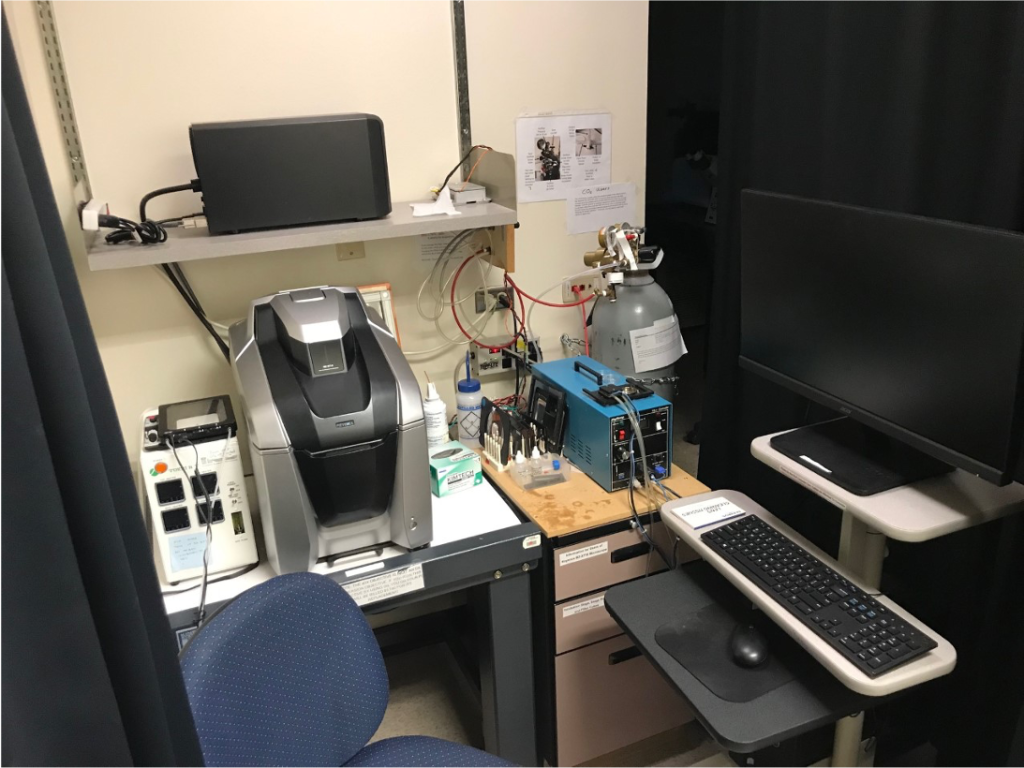Location: Room 224 Molecular and Radiological Biosciences (MRB) Building
The fully enclosed stage chamber of this Keyence microscope allows all imaging to be done under normal room lighting conditions. The microscope is fully under computer mouse control for X,Y,Z stage control, filter cube selection and turret objective switching. Objectives are 2x, 10x, 20x, 40x air, 100x oil, and a 40x long working distance phase contract objective. Image capture allows selection of a center or corner of a viewing area and can automatically capture images at up to 4 wavelengths in an automatically mapped out viewing area for arrays from 3×3 to 29×29 fields from slides, culture dishes or microtiter plates. Within each capture it is also possible to utilize a z-stack (0.1 μm minimum step size) to build 3 D images or capture a stack through a cell layer and then create a full focus (projection) image. Structured illumination can be used to acquire the image stack to improve the resolution to confocal quality. Stitched arrays are easily created from the single array images using the Keyence Analyzer Stitching program, a second copy of which is available on a separate workstation in an adjacent room. Filter cubes (4) are easily switched in and out during observations without the need to turn off the light. Standard configuration has DAPI (405 nm), GFP (488 nm), mRFP (561 nm) and an open position for brightfield but cubes are available for YFP (515 nm), Cy5/iRFP (640 nm) and NeuO, a neuronal viability stain that is excited at 488 and emits at >620 nm. In brightfield mode, oblique illumination is used to achieve near DIC image quality. A Tokai-Hit stage incubator for temperature, CO2, and humidity control is also available for live cell work. The Keyence can obtain stacks through 500 µm thick slices. The unit has a high sensitivity cooled monochrome CCD that is converted to a CCD 3 color camera for stained images at the click of a button. A large, motorized stage, high-speed autofocus, low photobleaching mode and real-time image overlays are features of the core microscope. High resolution (single pixel), standard resolution (2×2 binning) and high sensitivity (3×3 binning) are selected by a click of the mouse. Advanced imaging functions that are all available include image stitching in either an autofocus mode for each image (slow) or full focus wide-area (about 30 sec to scan a single plane mouse hippocampal slice in brightfield and display the montage), navigation (maintains image of montage on side panel and lets you see on the montage where you are located for higher magnification imaging), optical sectioning, and time-lapse. A structured illumination module uses projection of an optical grid to achieve super-resolution fluorescence images.
A Peltier cooled stage adapter is available for use on this microscope (see ancillary equipment).
Analysis software includes hybrid cell counts (can use dual fluorescence or brightfield/fluorescence to automatically quantify the % of cells expressing tags, color extraction (for stained sections) and masking functions for selection of regions of interest.
For Training and use of this equipment contact: Alisa Shaw, 970-443-5370 (alisa.shaw@colostate.edu)
Training on the use of MOAI light/fluorescence microscopes will be provided by facility supervisors or their designates. For all confocal microscopes and the atomic force microscope, a minimum cost ($250) is associated with the hands-on training sessions, which often run 3 hours. This cost also includes 5 hours of access time to the instrument for recently trained users to consolidate their training to become independent users. The Vectra Polaris is only available as a fee-for-service system. Training on the Keyence All-In-One Fluorescence Microscope is $40 per trainee and usually takes 40 min to 1 hr.

